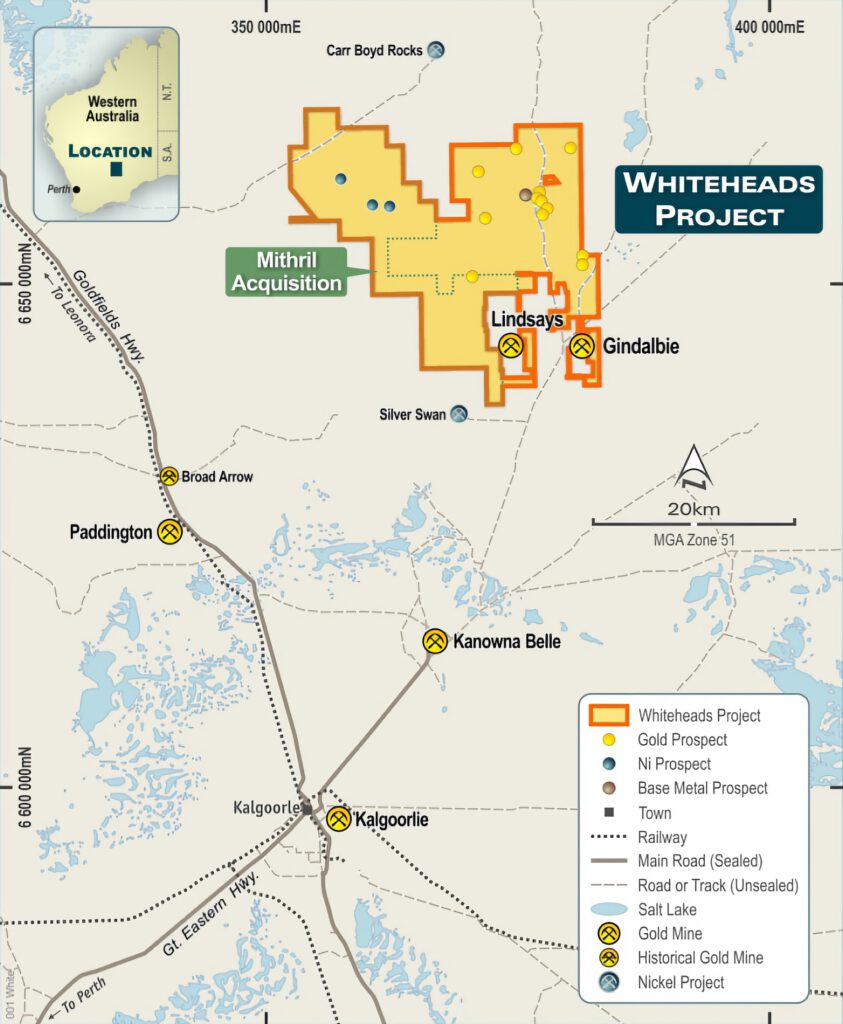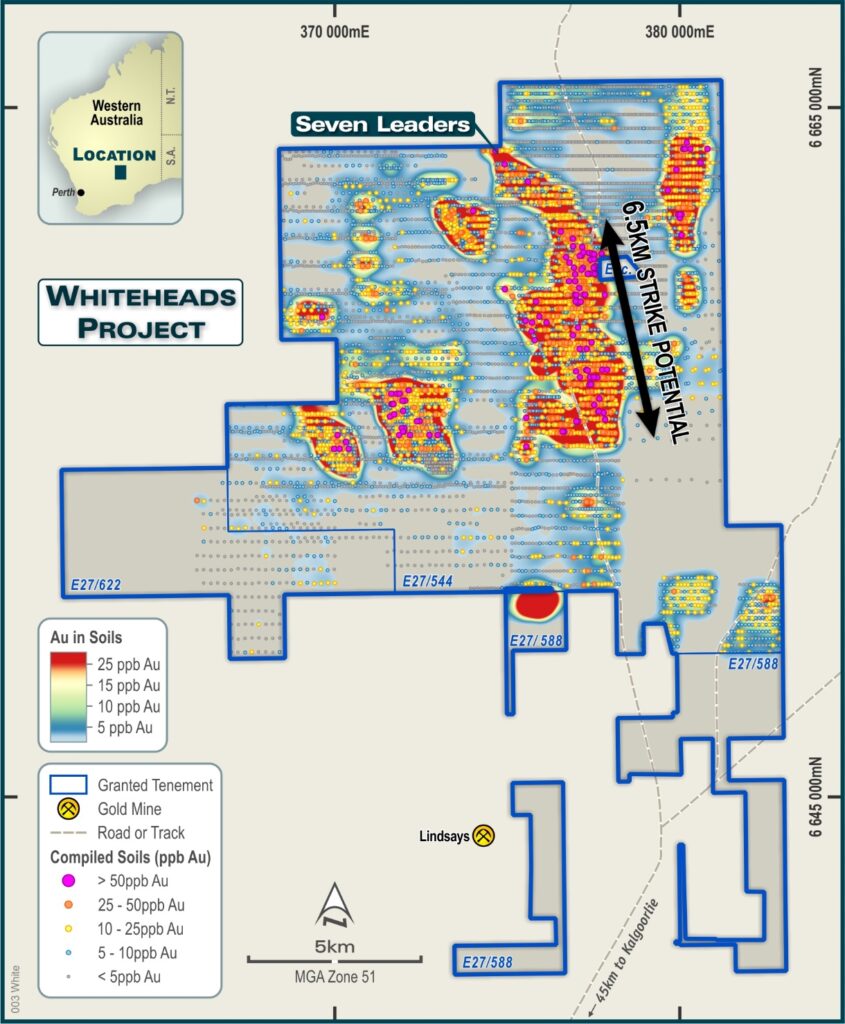
Whiteheads Project
The Whiteheads project is located approximately 40km north of Kalgoorlie in Western Australia, and north of the Kanowna Belle gold mine. Exploration by Great Boulder led to the discovery of gold at Blue Poles, within the 22km-long Arsenal trend. Much of this area remains unexplored with excellent potential for further gold, nickel and base metal discoveries.
Project highlights
Farm-in and joint venture agreements signed 2019
Commenced field exploration H2 2019
Blue Poles discovery 2020
Multiple gold in soil anomalies identified across ground previously poorly explored for gold mineralisation
Whiteheads is located 40km north of Kalgoorlie and north of the Kanowna Belle gold mine.

About the Whiteheads Project
Whiteheads is an amalgamation of two exploration agreements by Great Boulder in 2019. The eastern half of the project is a joint venture with Zebina Minerals Pty Ltd, with Zebina holding a 25% interest free-carried through to a decision to mine.
The western half of the project is subject to a farm-in agreement with Mithril Resources Ltd.
The Whiteheads project is a highly attractive area for gold exploration because, in spite of the amount of work done by previous explorers, its recent history has been one of fragmented ownership by multiple companies. As a result, Great Boulder has a unique opportunity to optimise the potential of Whiteheads as an advanced gold project with walk-up drill targets and multiple other untested surface gold anomalies.
Historical drilling intersections at Whiteheads include:
- 8m @ 7.19g/t Au from 74m in SL083 (Seven Leaders prospect)
- 23m @ 2.920g/t Au from 87m to EOH in SL068 (Seven Leaders)
- 7m @ 5.91g/t Au from 64m in LBRC013 (Lady Betty prospect)
- 3m @ 6.62g/t Au from 60m in LBRC007 (Lady Betty)
- 3m @ 11.90g/t Au from 75m in LBRC008 (Lady Betty)
Old workings at Whiteheads Find

Seven Leaders and Lady Betty are both on the Whiteheads mineralised corridor, a zone extending in a south south-easterly direction for over 9km from the northern tenement boundary before disappearing under an area of transported cover, and characterized by multiple old gold shafts, high-grade drilling intersections such as those highlighted above, and a large coherent gold-in-soil anomaly stretching for over 6.5km at over 25ppb Au.
Geologically the Whiteheads project straddles the terrane boundary between rocks of the Kalgoorlie Terrane to the west, and the Kurnalpi Terrane to the east. The presence of deep crustal structures such as this, as well as other large-scale structures striking north-northwest through the project, is significant for the potential for these features to act as a conduit for mineralising fluids, particularly for structurally controlled gold deposits.
Whiteheads straddles the terrane boundary between the Kalgoorlie and Kurnalpi Terranes. Seismic interpretation by GSWA indicates this deep crustal boundary dips east.

Geophysics
In early 2021 Great Boulder completed a detailed gravity survey over the eastern area of the Whiteheads Project. When combined with gravity data collected earlier on the western part of the project by Pioneer Nickel this provided complete high-resolution coverage over the project.
The survey confirmed a large corridor of low gravity striking south beneath the Arsenal Trend, on the eastern side of Whiteheads. This is interpreted to represent a spine of underlying granitic batholith from Gunners down to the Four Dudes prospect, a distance of over 20km.
This interpretation may represent a corridor for mineralising fluids passing through the Arsenal Trend, driven by heat from granitepluton in the north. This would explain the wide-spread surface gold anomalism within the Arsenal Trend, and also an apparent north-south temperature gradient evident in observations of alteration minerals and litho-geochemistry.

Geochemistry
The Whiteheads Project was first identified by GBR due to the wide-spread, high tenor gold anomalism present in surface sample data. Gold appears to have undergone highly efficient scavenging within the regolith profile with multiple >25ppb gold anomalies and individual soil samples up to 2g/t Au. This includes a 6.5km long anomaly that defines the Whiteheads Find to Seven Leaders gold trend.
While the bulk of historical work was focused on testing the Whiteheads Find trend, GBR has focussed on using Auger drilling combined with multi-element chemistry to generate targets in new areas of the project. This work as resulted in new gold and pathfinder anomalies being identified at the Wishbone, Forty Flats, Arsenal Trend, Eclipse and Jubilee North prospects.
A project wide campaign was undertaken to gather all existing bottom of hole chips from historical drill holes and submit these samples for multi-element geochemical analysis. Historical work often would analyse for a single target element (in some cases nickel not gold). The results from this work highlighted key pathfinder element anomalies and stratigraphic units that need further exploration.

Blue Poles Discovery
Analysis of the large volume of historical data at Whiteheads highlighted the large number of existing gold prospects in the area, many of which had previously been drilled with RAB, AC and a small number of RC holes. Rather than continue down the same path as previous explorers GBR’s geologists looked for prospective areas of geology that had not been previously tested.
The Arsenal Trend on the east side of Whiteheads was a known nugget-producing area with some historic soil sampling showing anomalous gold values. Great Boulder started systematically covering this trend from north to south wide wide-spaced auger lines, which quickly defined a large coherent gold anomaly centred around the Blue Poles area.
AC drilling at Blue Poles confirmed gold anomalism at the base of weathering. This was followed up by RC drilling, with early results such as 52m @ 1.02g/t Au in 20BPRC006 indicating a thick zone of gold mineralisation.
Follow-up RC drilling confirmed a wide cigar-shaped lens of supergene mineralisation at Blue Poles over a strike of approximately 400m, with thickness tapering at either end to give an overall strike of 700m, which remains open to the south. One of the last holes drilled at Blue Poles intersected 3m @ 5.51g/t Au at depth, suggesting a southerly plunge from the supergene zone into higher-grade primary mineralisation at depth. An Exploration Incentive Scheme grant has been approved for deeper RC and DD drilling at the Blue Poles prospect during 2022-2023.
Recent RC intersections at Blue Poles have intersected mineralisation over 700m of strike, with the best grades at depth at the south end.

While the main zone of gold mineralisation defined to date at Blue Poles is supergene enrichment around the top of fresh rock, RC drilling suggests a southerly plunge with higher grades in fresh rock at depth.

Further Work
The Blue Poles discovery resulted from systematic, phased exploration starting with conceptual target theories through surface geochemistry, AC drill testing and deeper RC drilling. This approach is continuing at Whiteheads, moving south along the Arsenal Trend and also testing new areas to the south and west.
A number of prospects have been defined on the Arsenal Trend, including Tektite, Gunners and Indicia, and these are being tested with AC drilling on a campaign basis.
The western side of Whiteheads is an area which has historically been the focus of nickel sulphide exploration due to its proximity to the high-grade Silver Swan nickel mine. As a result there has been little work done on the gold potential of the area, and Great Boulder is now testing this area with auger geochemistry and aircore drilling.